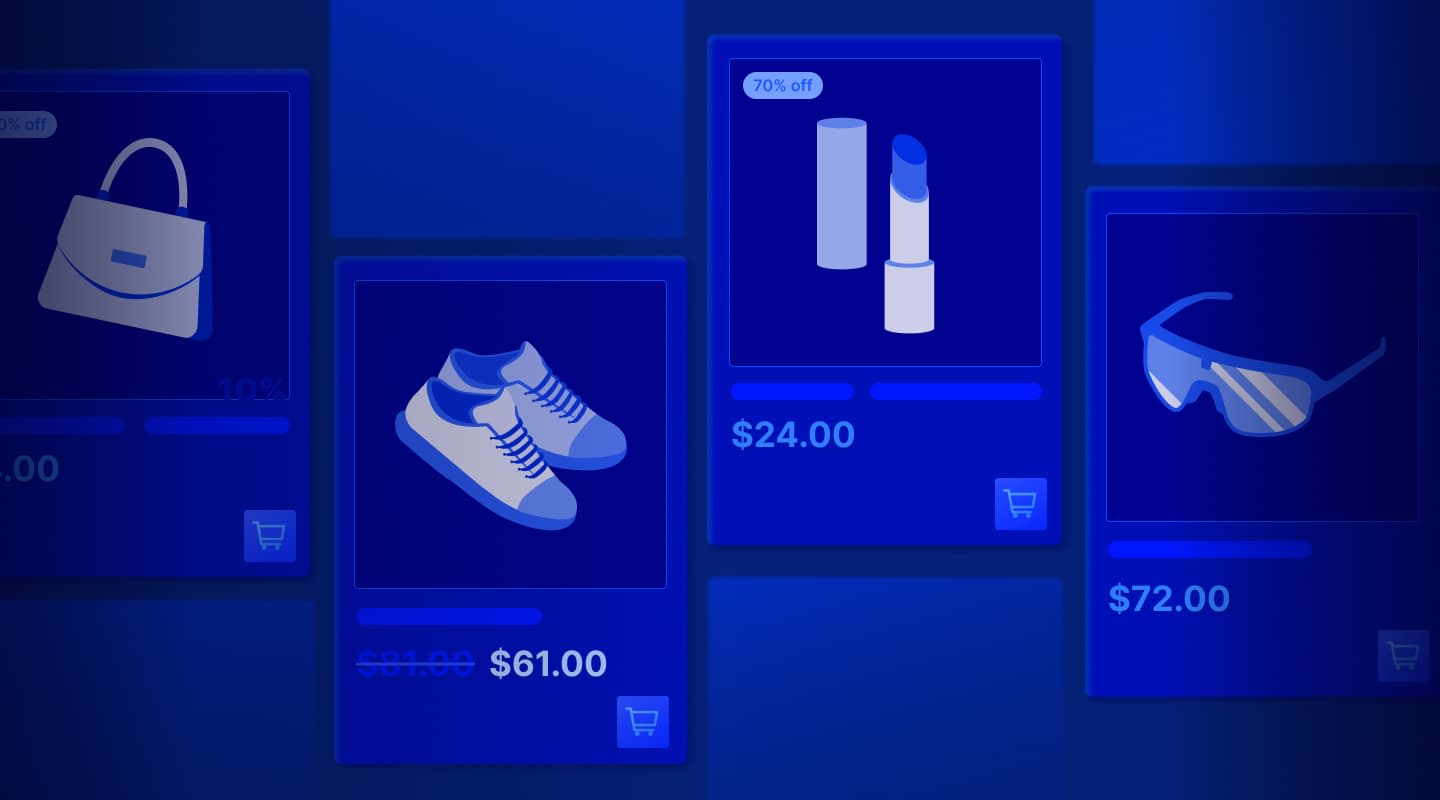Add InstantSearch and Autocomplete to your search experience in just 5 minutes
A good starting point for building a comprehensive search experience is a straightforward app template. When crafting your application’s ...
Senior Product Manager

A good starting point for building a comprehensive search experience is a straightforward app template. When crafting your application’s ...
Senior Product Manager

The inviting ecommerce website template that balances bright colors with plenty of white space. The stylized fonts for the headers ...
Search and Discovery writer

Imagine an online shopping experience designed to reflect your unique consumer needs and preferences — a digital world shaped completely around ...
Senior Digital Marketing Manager, SEO

Winter is here for those in the northern hemisphere, with thoughts drifting toward cozy blankets and mulled wine. But before ...
Sr. Developer Relations Engineer

What if there were a way to persuade shoppers who find your ecommerce site, ultimately making it to a product ...
Senior Digital Marketing Manager, SEO

This year a bunch of our engineers from our Sydney office attended GopherCon AU at University of Technology, Sydney, in ...
David Howden &
James Kozianski

Second only to personalization, conversational commerce has been a hot topic of conversation (pun intended) amongst retailers for the better ...
Principal, Klein4Retail

Algolia’s Recommend complements site search and discovery. As customers browse or search your site, dynamic recommendations encourage customers to ...
Frontend Engineer

Winter is coming, along with a bunch of houseguests. You want to replace your battered old sofa — after all, the ...
Search and Discovery writer

Search is a very complex problem Search is a complex problem that is hard to customize to a particular use ...
Co-founder & former CTO at Algolia

2%. That’s the average conversion rate for an online store. Unless you’re performing at Amazon’s promoted products ...
Senior Digital Marketing Manager, SEO

What’s a vector database? And how different is it than a regular-old traditional relational database? If you’re ...
Search and Discovery writer

How do you measure the success of a new feature? How do you test the impact? There are different ways ...
Senior Software Engineer

Algolia's advanced search capabilities pair seamlessly with iOS or Android Apps when using FlutterFlow. App development and search design ...
Sr. Developer Relations Engineer

In the midst of the Black Friday shopping frenzy, Algolia soared to new heights, setting new records and delivering an ...
Chief Executive Officer and Board Member at Algolia

When was your last online shopping trip, and how did it go? For consumers, it’s becoming arguably tougher to ...
Senior Digital Marketing Manager, SEO

Have you put your blood, sweat, and tears into perfecting your online store, only to see your conversion rates stuck ...
Senior Digital Marketing Manager, SEO

“Hello, how can I help you today?” This has to be the most tired, but nevertheless tried-and-true ...
Search and Discovery writer
Imagine an online shopping experience designed to reflect your unique consumer needs and preferences — a digital world shaped completely around you.
That’s not hard to imagine, is it? Because on many ecommerce websites, it’s already a reality.
You might have experienced such royal treatment on landing pages, home pages, product listing pages (PLP), product detail pages (PDP, or product pages for short), and check-out pages. If you’re an average online consumer, you’ve gotten used to being electronically pursued, pampered, and prodded to complete purchases.
PLPs — product listing pages, also known as product category pages — are just that: groupings of a number of products on an ecommerce website. These web pages are based on a category or produced by a search query.
It’s like on the Barnes & Noble website when you navigate to the mystery novels category landing page:

You’re greeted by an attractive layout with a list of products: a bunch of book covers — maybe the genre’s bestsellers — with the titles, authors’ names, and combined customer ratings. If there’s too much information, you can narrow it down by filtering the listings, such as by date of publication or novels boasting five-star customer reviews (this is convincing social proof).
These pages are starting points where potential customers can browse collections of products before clicking on one that looks interesting. When a shopper finds something they like, they can head to its specific product detail page, where they can immerse themselves in the product description, peruse the product information and specs (if applicable), and look at the photos, preferably from various angles. If they like what they see, and your call to action (CTA) — such as an add-to-cart button — is enticing, they could click Buy.
As an ecommerce sales manager, to help shoppers, you probably pay lots of attention to your homepage, product detail pages, and landing pages targeted for social-media leads. However, in order to optimize for conversion, you need to apply an equivalent level of thought and strategy to your PLPs.
To boost conversion, optimizing PLPs is just as crucial as creating an engaging home page. Your shoppers want certain products, and your product listing pages can open the virtual doors to those items. From influencing their purchasing decisions to impacting your revenue, they’re a fundamental feature of every successful ecommerce platform.
PLPs facilitate discovery. They act as touchpoints where shoppers can explore and discover relevant product categories that may lead them to subcategories and individual items. The arrangement, categorization, and presentation of items on these gateway pages can greatly influence how people navigate through and experience your ecommerce site.
They also enhance site performance. The information displayed on PLPs lets shoppers make informed decisions about where to go next. That contributes to a positive customer experience, which, of course, can bolster performance. Your PLP merchandising efforts will determine whether your shoppers hit dead ends and jump to another site or succeed in finding what they want, head to checkout, enjoy their purchase, and come back for more shopping adventures.
Product-listing-page design that works is typically not one size fits all; you need to tailor it to best reflect your product offerings. In general, you want:
In a PLP format, shoppers expect to see (perhaps) a visually appealing hero image or banner, plus high-quality thumbnails that accurately show the items they may decide to explore.
In order to build trust with prospective buyers, you need the product names, prices, and other listing-page details to be correct.
A PLP should enhance usability by providing sorting and filtering that allows shoppers to refine their search results based on parameters such as price, popularity, category, size, and color.
Getting the elements of a product listing page right is one thing; optimizing the page for maximum conversion is another. A smooth customer journey that directs someone to the best product for their needs requires:
Is your navigation intuitive and shopper friendly? If someone searches for a green velvet jacket in size XL, can they quickly find it? Some products have complex specifications, and shoppers have specific tastes, so good navigation is imperative.
By conducting usability testing, you can identify ways to streamline your navigation to potentially reduce the number of clicks to reach a product detail page. Then, when you update your hierarchy and menu labels, your conversion rates could show significant improvement.
Do you need to add any high-ranking SEO terms to your PLP pages so shoppers will easily find them? Identify the most relevant and high-impact keywords. Optimize your product titles, descriptions, and meta tags to achieve the best results.
Let’s say you’ve put a ton of effort into crafting your PLPs, only to realize that these changes don’t work when people are looking at your pages on mobile devices, which happens often. Sigh. Your images are too small, columns are too wide, star ratings aren’t appearing, text is unreadable.
You can avoid this peril by taking a mobile-first approach. Upgrade and test your mobile functionality and identify any usability challenges, then optimize the placement and functionality of your UI elements to create a seamless mobile experience.
A/B testing is key if you’re wanting to show your audience the best PLPs. You can test things such as different layouts, grid vs. list view of the items, the attractiveness of product images, and sorting options. You never know what you’ll find out about how you can better present information.
By regularly auditing your PLP performance, you can identify and rectify issues impacting their functionality. How long do shoppers spend on these gateway pages? What are the bounce rates? Are all the links working? When you’ve finished auditing, make changes to address any problems.
Shoppers overwhelmingly want personalized experiences: a study by McKinsey highlights that 76% are more likely to purchase from websites that personalize the shopper journey.
That means it pays to utilize your shopper data and behavior analytics to tailor people’s search results so they can immediately find their desired PLPs. Search personalization can transform generic listings into curated, engaging experiences. Using data such as behavior, preferences, and purchase history, you can give shoppers targeted information that effectively addresses their needs. Such unparalleled service has been known to increase conversion and drive up customer loyalty.
To successfully implement PLP personalization:
Personalization relies on being able to respond based on your shoppers’ data. Collecting their behavior, preferences, purchase histories, and demographics lets you form a foundation for creating effective personalized experiences. By extracting meaningful insights from this wealth of information, you can drive personalized content recommendations on your PLPs.
Targeting individual shoppers is one strategy; grouping shoppers based on common characteristics, behaviors, and preferences is another way you can tailor your PLP content. For example, if a group of shoppers is interested in electronics products, you can create an electronics-focused set of PLPs for them.
You can put machine learning algorithms to work analyzing vast amounts of data to understand patterns and predict shoppers’ preferences. Taking advantage of such AI capabilities lets you create a continually optimized PLP design that personalizes content and recommends what your shoppers want based on their real-time interactions.
At the top of the page, your PLPs can display special offers and exclusive product discounts that reflect a shopper’s past interactions, prospectively motivating them to make a purchase. If your shopper is an avid gamer, for example, you can show them a PLP aligned with related different products, cross-sells and upsells that cater to their gaming tastes.
When it comes to optimizing the website design for the PLPs in your ecommerce store, you’re on the right track!
However, when it comes to your search engine, you may have more work to do. Because if your shoppers can’t find the beautiful optimized PLPs for the individual products they need, you’re in trouble.
As search providers go, Algolia is first rate. Our AI-aided platform has helped leading online retailers reach new revenue-generation heights with their ecommerce businesses. You can also use Algolia to help customers browsing PLPs in your online store effectively zero in on their desired products.
Discover how our advanced search and personalization can better bridge your PLPs to your PDPs, enhancing your user experience, and potentially improving your metrics and boosting your conversion. Contact us or get a demo to learn more.
Senior Digital Marketing Manager, SEO
Powered by Algolia Recommend